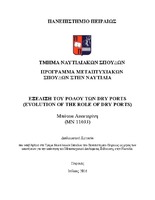| dc.description.abstractEN | When the term dry port is used nowadays, what interested parties actually refer to, is “a
seaport directly connected by rail to inland intermodal terminals, where shippers can leave
and/or collect their goods in intermodal loading units as if directly at the seaport”1.
This paper shall present how dry ports have evolved in recent years, always with a view to
improve and accommodate the shipping and logistic industries’ needs and requirements.
The purpose that is served, is to show how dry ports, sometimes referred to as the
“backbone” of the system, actually impact the overall performance of the entire
transportation network.
Although this is not a new concept, it, along with any related activities, has come to the fore
because of the rising needs of the international economy and the many advantages they
could offer.
Proper implementation could bring astonishing results in various fields such as the
environment, time which could be utilized otherwise and even lower the risks on the roads
while trucks carry various materials. Such examples of basic advantages could be the
decrease of CO2 emissions, reduction of queues and long waiting times at now congested
seaport terminals.
The above would, in turn, achieve regional sustainability and the terminals’
competitiveness would increase.
One possible way to go about bringing those results would be the utilization of rail
transportation, which would need to become partially automated (in the sense that it
grows to the point, that it becomes cheap, scheduled and reliable).
The very special nature and the complex way in which they are structured, makes the
evaluation of any possible improvements very challenging and hard to establish. Processes
are inter-connected and no change in any parameter could avoid impacting others2.
The basic pre-requisite is that, dry ports’ evolution, needs to be consistent and continuous,
instead of partial and fragmentary. Their operable performance can be gauged through the
evaluation of the effectiveness and efficiency of those dry ports’ processes.
The methodology used in this paper is based on extended literature review and pieces of
information obtained from the respective worldwide organizations. The validation,
regarding their implementation, has been cross-checked and is based on the various
reviews, researched options and real-life results. | el |



